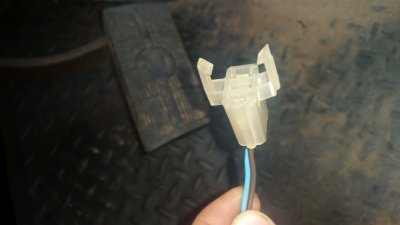The sensing leg of any dash gauge is
designed to be connected to ground and it
only connects to the negative side of the coil. This is my take on how a GM gauge works:
Just as a general discussion on the gauge/sender/ground relationship - and to make sure I have the theory of operation straight in my mind;
The components mentioned above form the "sensing leg" of the coolant gauge located in the instrument panel. They are connected by the green wire (gauge to sensor) and thread engagement (sensor to engine block). To complete the circuit, the engine block is connected to the battery negative post by the main grounding cable.
12 volts is supplied to the post/terminal on the coolant sender (via the green wire). It's source is the negative side of the gauge's measuring coil.
The less resistance in this total combined circuit, the greater the electron flow through the coil wires - and consequently the stronger the force that it (the measuring coil) can exert on the gauge's magnet. The magnet is attached to the lower end of the indicating needle. Something like this:
You must be registered for see images attach
In addition to the sensing leg, there is another - opposing - circuit called the "control leg". It is identical to the sensing leg in every way except that the negative side of it's coil is lead straight to ground (rather than through a variable resistance and then to ground like the sensing leg). Also, it's coil is located on the opposite side of the magnet from the measuring coil's.
So what you have is; two coils located on either side of an indicating needle - AKA the "ray". The ray is pivoted somewhere in the middle and has an integral magnet mounted at the bottom.
These coils create their own magnetic fields - the strength of which is a function of the electron flow (i.e. current) passing through them. When these circuits are energized - by turning the ignition switch to the RUN position - the opposing magnetic fields begin to "fight it out". Each coil tries to pull the magnet - mounted on the needle - towards itself.
Due to the fact that it's negative leg is run straight to ground - resulting in nearly zero resistance, the current flow through the control coil is essentially constant (as is it's magnetic force).
On the other hand, due to the variable resistance generated by the sender (as a result of changes in coolant temperature), the current flow/magnetic strength of the measuring coil can be higher or lower than that of the control coil.
The location of the two coils - to the magnet - is such that:
1. The control leg is always trying to peg the indicating ray to the left (i.e. cold) end.
2. The sensing leg is always trying to peg the ray to the right (i.e. hot) end.
So as extreme examples:
1. If the green wire to the sender is broken/disconnected the control leg exerts the greater force and pegs the needle to the left/cold end.
2. If the green wire is allowed to contact directly to ground (before passing through the sender), the sensing leg has a greater force. This causes the ray to peg out to the right/hot end.
As GM explains it (better and way more succinctly than I can):
VARIABLE VOLTAGE TYPE
The variable voltage type dash gauge consists of two magnetic coils to which battery voltage is applied. The coils act on the gauge pointer and pull in opposite directions. One coil is grounded directly to the chassis, while the other coil is grounded through a variable resistor within the sending unit. Resistance through the sending unit determines current flow through its coil, and therefore pointer position.
When resistance is high in the sending unit, less current is allowed to flow through its coil, causing the gauge pointer to move toward the directly grounded coil.
When resistance in the sending unit decreases, more current is allowed to pass through its coil, increasing the magnetic field. The gauge pointer is then attracted toward the coil which is grounded through the sending unit.


